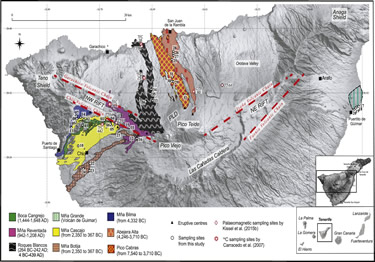Refining the Holocene eruptive activity at Tenerife (Canary Islands): The contribution of palaeomagnetism

Risica G., A. Di Roberto, F. Speranza, P. Del Carlo, M. Pompilio, S. Meletlidis, M. Rosi (2020).
Journal of Volcanology and Geothermal Research, 401, https://doi.org/10.1016/j.jvolgeores.2020.106930.
Abstract
The timing of the Holocene volcanic activity of Tenerife (Canary Islands) is poorly constrained and the volcanological framework for this area is still incomplete. Most of the eruptions are dated only by a single 14C dating, or the ages are simply stratigraphically determined. We apply palaeomagnetism, increasingly used in the last years to date Holocene volcanism, to improve the knowledge of Tenerife volcanic history. We report on the palaeomagnetic dating, using the SHA.DIF.14K global model, of nine Holocene eruptions that produced scoria cones and major lava flows, and we compare our results with those previously obtained by 14C method. Four of the studied eruptions were previously dated by 14C, four were stratigraphically constrained, and one was never dated so far. Concerning the first group, for Boca Cangrejo and Mña Reventada eruptions, palaeomagnetic and 14C ages agree, while for the others we obtained older or younger ages than radiocarbon data. For the second group, one or more age ranges smaller than stratigraphic intervals were found. Finally, we provided the first dating (790–723 BCE) of the Mña Grande eruption. We confirm that palaeomagnetism can be considered an excellent complement to the radiocarbon method, because it is applicable on volcanics with nearly all compositions and provides higher resolution dating, at least where reliable geomagnetic reference curves are available. The improved framework of the Holocene volcanic activity of Tenerife shows alternating periods characterized by low and high eruptive frequencies, with the last 3 kyr characterized by high eruptive frequency and dominated by basaltic eruptions.


Devi effettuare l'accesso per postare un commento.